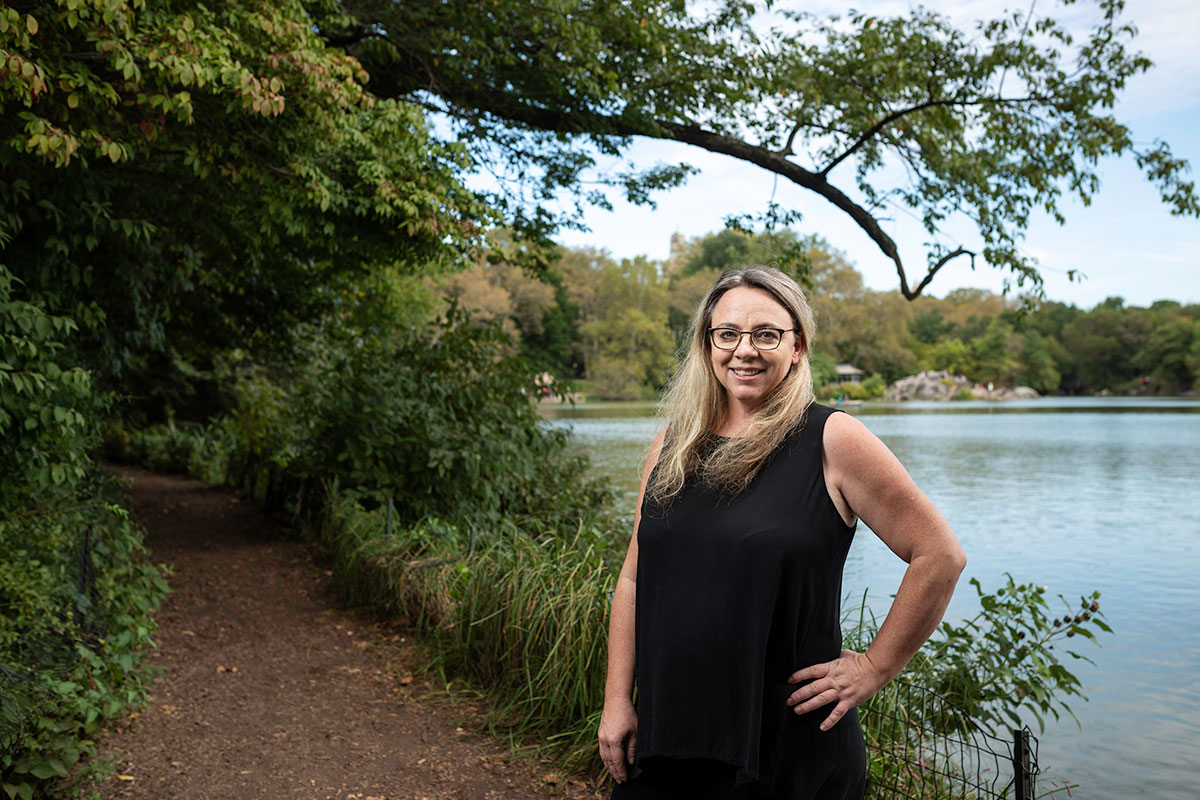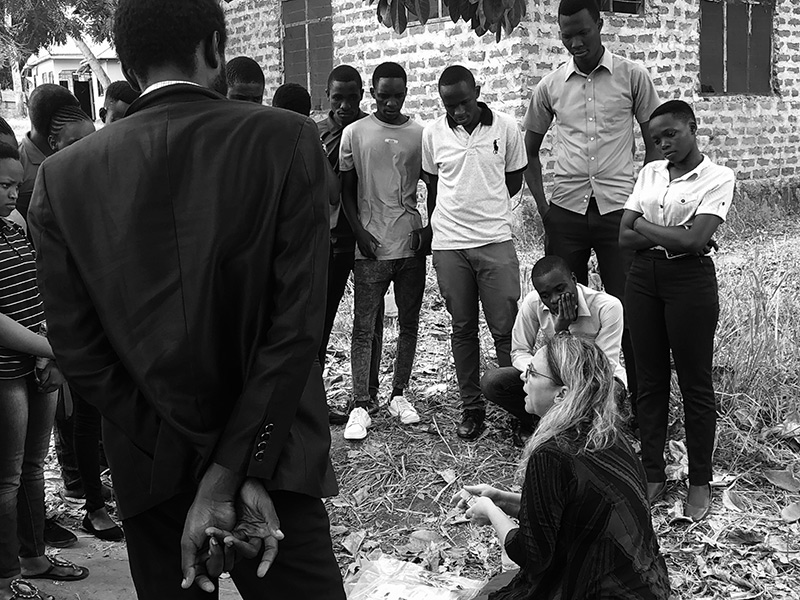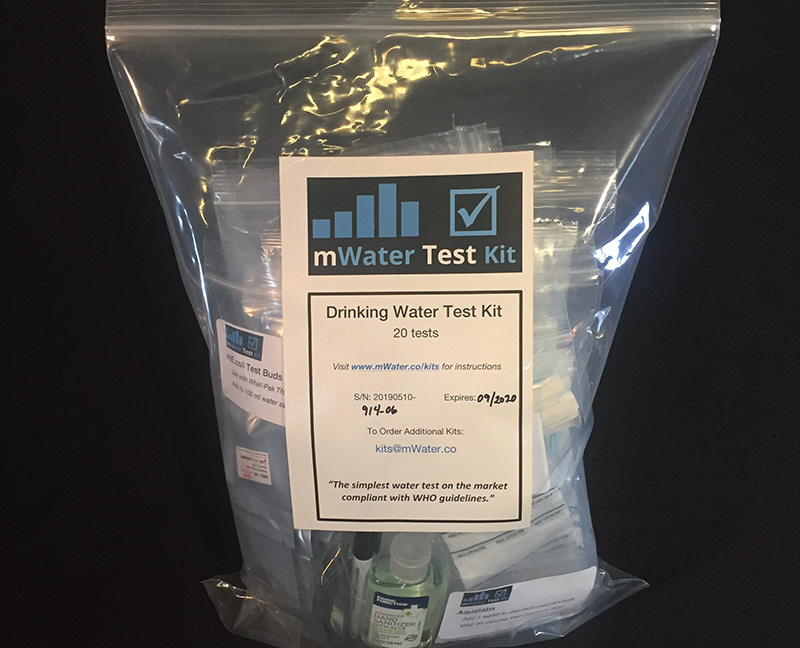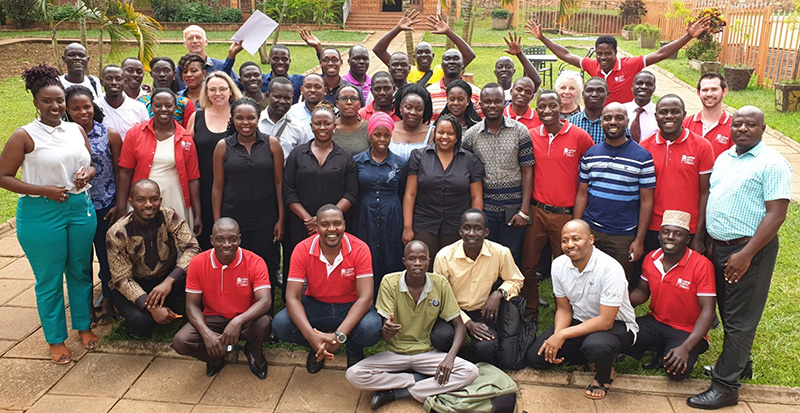The inland port of Mwanza, Tanzania sits on the banks of Lake Victoria, the largest lake in Africa. There is water everywhere, but for many residents of the impoverished “informal settlements” on the city’s outskirts, not a drop to be safely drunk.
Seven years ago, when Annie Feighery (rhymes with “theory”) and her husband, John, first visited the region to pitch their new web-based water monitoring technology, aid groups were helping families to hand-dig their own wells. But with families emptying their latrines directly on the rocky, boulder-strewn slopes, the water was contaminated with E. coli bacteria that were causing cholera outbreaks and other diarrheal diseases.
Under the old regime of yearly surveys, expensive testing by high-tech labs, and lengthy written reports, it would likely have taken decades to document the unfolding crisis and get information to the right people.
By 2012, however, the Web 2.0 revolution was in full swing. The thirty-something Feigherys — Annie, a Teachers College- and Columbia University-trained public health scientist, and John, a former NASA engineer — were in its vanguard, decidedly more Silicon Valley than Peace Corps. Through their nonprofit start-up, mWater, they were offering data, digitally collected and immediately actionable. Their new app, Surveyor, combined a cheap but reliable water-testing kit with a smartphone app that allowed users to share information in real time.
When the couple demoed Surveyor for local officials and families, they could immediately show them contaminated water, which changed color in response to the test. Even more powerfully, they could upload that information, with maps showing impact on surrounding areas and various populations, to a free database, viewable by all.
Flash forward to today. Mwanza still has massive water problems, but there have been significant advances, and the Feigherys’ hand is evident. The region’s non-governmental organizations are drilling deep bore holes instead of digging shallow wells. Since 2017, the Lake Victoria Water and Sanitation Programme — backed by UN-Habitat, a major mWater client — has brought clean water to several settlement communities. Officials from the local water authority report that mWater’s mapping allows them to collect additional revenues from high-end users such as hotels and mines.
“There is hope,” reported a recent UN-Habitat publication. “Lake Victoria Water and Sanitation Programme in Mwanza has been able to provide access to sanitation through the simplified sewerage system as well as access to clean water supply. Residents of the informal settlements have a reason to smile.”
Going Against the Flow
If the ’60s were the Age of Aquarius, the global warming era is its dark opposite — a time when water is rapidly becoming the world’s scarcest resource. To rehearse just a few of the most terrifying statistics:
- Global water use has quadrupled over the past century, and water demand is projected to grow by 55 percent by 2050.
- By 2030, humanity’s “annual global water requirements” will exceed “current sustainable water supplies” by 40 percent.
- By 2025, an estimated 1.8 billion people will live in areas plagued by water scarcity. Two-thirds of all people will live in water-stressed regions.
- Water demand in India will reach 1.5 trillion cubic meters in 2030 while India’s current water supply is only 740 billion cubic meters.
But while water scarcity looms, it’s the fecal contamination in available water — the Feigherys put it a bit less delicately in talks they give to the health community — that constitute the more immediate problem. A child dies of a water-related disease every 15 seconds, and diarrheal disease, which claims the lives of 1.5 million children every year, is largely caused by people drinking contaminated water.
Unsafe water is most dangerous for children under five, and children who survive the water source are likely to be physically and/or mentally stunted.
—Annie Feighery
“What we really want people to understand,” says Annie Feighery, who serves as mWater’s CEO (John is Chief Operating Officer), “is that unsafe water is most dangerous for children under age five, and children who do survive the water source are very likely to be physically and/or mentally stunted.”
What’s most needed, Feighery firmly believes, is not the sweat of Peace Corps volunteers toiling at the village level, but instead information, data sharing, coordination and cooperation.
“Relational databases, cloud-based data management, multiple digital channels that span from mobile operating system native to mainstream app-integrative, and API interoperability are all standard practice for every single vertical in the aid industry,” she writes in her occasional blog on Medium.com. “If you are not digital, you are a dinosaur.”
Since 2012, when the Feigherys launched mWater (the “m” is for “mobile”), they have rapidly won converts to that view. Through partnerships with UN-Habitat, USAID, the World Bank Innovation Fund, and leading NGOs such as Water.org and WaterAid, mWater’s platform has been introduced in 167 countries and used to survey and track some 3 million water sources. In Haiti, the government has adopted the mWater platform wholesale.
The mWater app is “a game changer for the rural areas and small towns that get forgotten in data management” for water safety, says Ellen Greggio, a monitoring and mapping adviser to WaterAid. “It’s really about accelerating government service providers” to make better and faster health decisions.
On one level, mWater’s operating philosophy of “what gets measured gets done” reflects changes in the larger global aid world. For example, thanks in great part to better and faster testing technology, the old UN Millennium goal, which was to reduce by half the number of people who lacked access to “nearby improved water sources” has been replaced by the Sustainable Development Goal of achieving global access to “safe and sustainably managed water systems.” Meanwhile, a new culture has emerged in which aid organizations and governments freely share data.
But mWater has also taken the lead in introducing new paradigms. Rather than pursuing traditional grants from philanthropic organizations, Feighery seeks “investors” — large aid groups who understand the utility of a ubiquitous platform and accessible maps and data, and who support making that data free to all users.
“mWater’s business strategy is borrowed from the tech industry to take advantage of Web 2.0 and the efficiency revolution,” Feighery writes. “In technology, the value of a platform increases with more eyeballs seeing it. Just as end users do not pay for Google or Facebook . . . we structured mWater in such a way as to charge the beneficiaries of a widely used, broadly applicable platform and left it free to the end user.”
mWater’s focus on investors rather than donors has also helped accelerate meaningful change. Data collection used to happen at the behest of funders, a system that, Feighery argues, had two major flaws. First, “outputs” were “collected, analyzed, and reported at the end of a ‘project,’” which meant that “errors in planning and adjustments for unforeseen events [were] not possible mid-stream.” And second, a project’s success or failure was “solely measured by the donor’s decision to re-fund . . . a perverse economic model, in which the recipient of the product has nothing to do with the judgement of the success of the product.”
The bottom line: Under the mWater business model, the real customer calling the shots isn’t the donor or even the aid organization — it’s the family living in the informal settlement that doesn’t have fresh water.
Roadside Philosopher
Feighery says her work at Teachers College and in her other Columbia programs helped her hone mWater’s contrarian ideas on how global aid does and doesn’t work. “I call it the aid industry,” she explains. “Some people are surprised — they say, ‘Hey, call it the humanitarian sector.’ But it is an industry in the flows of money and power. We are all motivated to make the world a better place — but if you can understand it as an industry, you can do a more impactful job working in it.”
I call it the aid industry. Some people say, ‘Hey, call it the humanitarian sector.’ But it is an industry in the flows of money and power.
—Annie Feighery
Still, that hard-edged worldview may also have been shaped by Feighery’s youth in the dusty New Mexico truck stop town of Tucumcari. (The name shows up in so many pop and country songs that she recently compiled a list for Spotify.)
Well known to cross-country travelers as a stop on historic Route 66 to fill up with gas and maybe snag a cheap motel room, Tucumcari looks different to the 3,000 or so people who live there. Feighery’s parents were both in the business of helping people — her dad as an agent for the railway workers’ union, her mom working at the local high school and later opening an experimental school for teens about to become parents.
Feighery had her own ideas about how to help people, and it involved a world far beyond the big sky of eastern New Mexico. “I immediately felt like I had this affinity for other countries and wanted a career that was international,” she recalls. She read incessantly — even a French dictionary, just to pick up the language — and visited Europe as an exchange student shortly before arriving at nearby University of Texas at El Paso, to study anthropology.
Her trajectory changed during freshman year, when she went on a date with another questing soul, John Feighery, whose dream was to become an astronaut. They married two weeks after graduation and relocated to Houston, where John became NASA’s lead engineer for air and water monitoring, focused on the space station program. During those years, Annie gave birth to their three children and became a pioneer in the so-called “mommy blogger” world, learning the art of social connection and the value of decentralized information.
In 2003, the space shuttle Columbia disintegrated on reentering the earth’s atmosphere, and flights were grounded for the foreseeable future. “John was heartbroken,” Feighery recalled, “but we’d always planned to take turns. He said, ‘OK, it’s time to focus on the next step in the flow chart — your career.’”
The next stop was New York City and Columbia. Annie earned a master’s degree from the School of International and Public Affairs before embarking on her doctorate in health education at TC. Working with Health Education Professor John Allegrante, she wrote her doctoral thesis on technology-assisted disaster response in earthquake-ravaged Haiti, which offered her a fresh perspective on social networking in the developing world.
Annie’s genius is in finding people who could help her not just in her courses but on how to do the most good.
—Robert Fullilove
“Annie’s genius is in finding people who could help her not just in her courses but on where to find other people, or how to do the most good,” says Robert Fullilove, Associate Dean for Community and Minority Affairs at Mailman and a Teachers College adjunct professor who taught Feighery in his course on the AIDS epidemic. For Feighery, Fullilove recalled, academic study wasn’t just a source of knowledge but also for the far-flung connections she’d need to launch mWater. He said he could remember no other student “who learned to work the system so successfully.”
Feighery credits Columbia and TC with introducing her to the concept of “social capital” and theories about the ways that people bond together, form communities and make choices.
“I thought this is exactly what explains how people make rational decisions and what can harm their health,” she says. “They need to prioritize short-term good sometimes, or certain relationships that will harm them, because of the stresses of poverty. And if you understand that better, then you can begin helping people break out of the health and well-being cycles that come from poverty.”
People prioritize short-term good sometimes, or relationships that will harm them, because of stresses of poverty. If you understand that, you can begin helping people.
—Annie Feighery
John Feighery, meanwhile, was completing a Ph.D in Earth and Environmental Engineering. And somewhere along the way, he and Annie realized that the technology he’d been working on to monitor water quality on the space station could easily be applied to other cramped, low-resource settings — like, for example, cities in the developing world. Together with a Montreal-based software developer, Clayton Grassick, the Feigherys launched their start-up even before they received their final diplomas. They chose the name “mWater” five minutes before their first grant application was due because it was the only one they could agree on.
Today, much in the Silicon Valley mode, mWater operates “lean and agile,” with just nine employees who work remotely in locations around the globe. Feighery herself rarely interacts with the villagers who might be drinking cleaner water because of the mWater app, though recently she trained students at Tanzania’s Mzumbe University on how to test a local water source in front of residents.
“Mostly I work with data and numbers,” she says.
But she’s no less mindful that the numbers are a means to a humanitarian end. This year, she announced the launch of Solstice, a new venture which aims to use the mWater technology to build new open-access databases for a broad array of public health issues.
“I’m an optimist,” she said in late September, reached by Skype in Mwanza. Despite the “water wars” already being waged in the Middle East and Africa, she sees more neighbors — Tanzania and Kenya, for example — cooperating on tackling climate change.
It’s helped, she said, to find such a like-minded soul in John. “We’re both so passionate — we’re in this righteous cause because we were made that way.” As she spoke, night was falling on Mwanza, half a world away from Tucumcari. “We were people who threw ourselves in a cause.”



